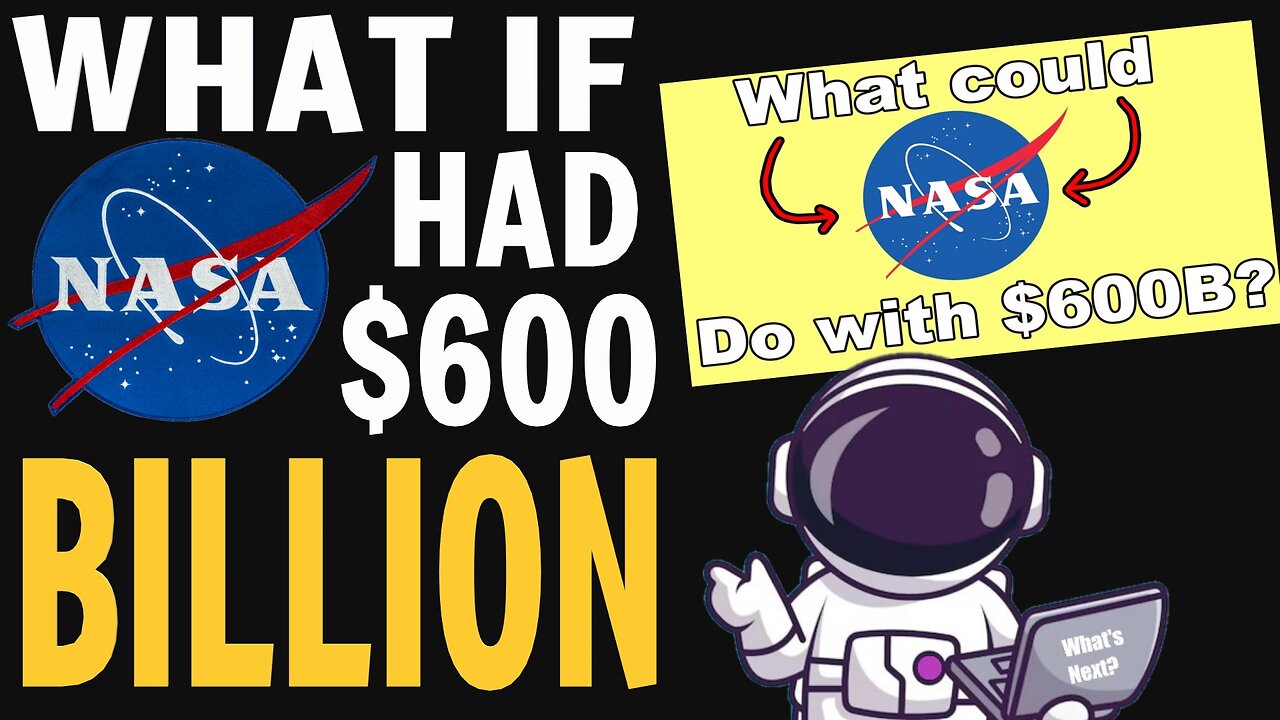Premium Only Content

The Truth About Second Thought's "What if NASA had the US Military's Budget?" Video Reaction Debunk
Please Support The Channel
50% of all channel support (after fees & tax) will go to a private Moon mission
Patreon: https://www.patreon.com/user?u=37594401
Buy Me A Coffee?: https://www.buymeacoffee.com/whats.next
Donate With Cash App: https://cash.app/$YTpayments
If the NASA and National Science Foundation’s budgets were increased to $600 billion annually, equivalent to the US military spending, here are five potential possibilities:
Net-energy-producing nuclear fusion reactor: With a single year’s worth of military spending, we could not only achieve nuclear fusion but also learn to scale it and revolutionize energy production on Earth. The ITER project, an international consortium aiming for net-energy-producing fusion reactors, has been ongoing since the Reagan-Gorbachev era and is expected to be completed in 2019 with a €20 billion investment. However, the primary barrier to achieving this goal is the upfront investment required.
Establishing multiple human colonies on Mars: Funding has been the only obstacle preventing humans from establishing colonies on Mars since the 1990s. A sustained investment of between $50 and $150 billion over ten years would enable us to land equipment and a crew on Mars, potentially setting up four separate colonies for the cost of one year of US military spending.
Providing 2,000 Watt solar power systems for every US household: Solar power technology is becoming increasingly efficient and cost-effective. For $600 billion, we could provide approximately 125 million US households with a 2,000 Watt solar power system each, significantly reducing their reliance on fossil fuels and easing the burden on electric grids.
Building a country-sized particle accelerator: With a budget six times larger than that of the Large Hadron Collider (LHC), we could construct a particle accelerator with a circumference of approximately 1,000 kilometers and achieve proton-on-proton collisions of over 500 TeV. This would allow us to potentially crack the PeV energy frontier and make significant strides in understanding fundamental physics.
Developing a “super-Hubble” space telescope: A space telescope ten times larger than Hubble in diameter would have ten times the resolution and observe objects that Hubble can only see after much longer observation periods. For $600 billion, we might be able to build a telescope with a diameter between 30 and 40 meters, significantly advancing our understanding of the universe beyond what Hubble has achieved.
Authoritative References Used:
European Fusion Development Agreement (ITER). (n.d.). About ITER - The world’s largest scientific collaboration for nuclear fusion energy research - ITER Organization - ITER Fusion Energy Research Project - ITER Fusion Reactor Design & Construction - ITER Nuclear Fusion Energy Research & Development - ITER International Partnership for Nuclear Fusion Energy Research & Development - ITER Nuclear Fusion Energy Technology & Innovation - ITER Nuclear Fusion Energy Education & Outreach - ITER Nuclear Fusion Energy News & Events - ITER Nuclear Fusion Energy Research Progress Reports & Publications - ITER Nuclear Fusion Energy Research Collaboration Opportunities & Partnerships - ITER Nuclear Fusion Energy Research Facility Tours & Visits - ITER Nuclear Fusion Energy Research Project Updates & Milestones - ITER Nuclear Fusion Energy Research Progress Reports & Publications Archive – ITER Organization (n.d.). Retrieved June 13, 2024, from https://www.iter.org/about/default_en.aspx
NASA (n.d.). Mars Exploration Program: Human Spaceflight: Mars Exploration Program: Human Spaceflight: Mars Exploration Program: Human Spaceflight: Mars Exploration Program: Human Spaceflight: Mars Exploration Program: Human Spaceflight: Mars Exploration Program: Human Spaceflight: Mars Exploration Program: Human Spaceflight: Mars Exploration Program: Human Spaceflight (n.d.). Retrieved June 13, 2024, from https://www.nasa.gov/topics/solarsystem/features/mars_human_exploration_factsheet_january_27_2014_revised_final_.html
National Renewable Energy Laboratory (NREL) (n.d.). Residential Solar Photovoltaic System Cost Analysis (Version 7). Retrieved June 13, 2024, from https://www.nrel.gov/docs/fy18osti/68879_residential_solar_photovoltaic_system_cost_analysis_-_version_7_.pdf
-
 LIVE
LIVE
GamerGril
2 hours agoThe E-Gril Within | First Time Play Through | Saturday Spookfest
145 watching -
 18:22
18:22
Liz Wheeler
3 hours agoWhat Ghislaine Maxwell Knows
5.97K12 -
 LIVE
LIVE
cosmicvandenim
6 hours agoWARZONE - Kenetik Energy Announcement - Discord Spy Bots
76 watching -
 1:05:51
1:05:51
Jeff Ahern
3 hours ago $16.99 earnedThe Saturday Show with Jeff Ahern
93.6K11 -
 LIVE
LIVE
Misfit Electronic Gaming
1 hour ago"LIVE" RUMBLE HALO Spartans "Halo MCC" 23 Followers to go till we hit !000 RUMBLE TAKEOVER
16 watching -
 1:57:13
1:57:13
Film Threat
5 hours agoLIVE FROM SAN DIEGO COMIC-CON! (Saturday) | Film Threat Live
12.6K -
 31:40
31:40
Tactical Advisor
3 hours agoEveryone Talks About This AR15 Being The Best? | Vault Room Live Stream 034
59.5K4 -
 1:08:53
1:08:53
Michael Franzese
17 hours agoHollywood Deaths & Political Secrets: A Nation at a Crossroads?
152K97 -
 9:27
9:27
MattMorseTV
1 day ago $16.07 earnedHe just lost EVERYTHING.
64.1K78 -
 1:40:30
1:40:30
I_Came_With_Fire_Podcast
16 hours agoPrivate Military Contractors Are TRAFFICKING KIDS Around The United States
40.8K26